With the lack of pharmaceutical solutions for nonalcoholic fatty liver disease, lifestyle is the primary factor in avoiding, reversing and alleviating the affects of the disease. “Lose weight” is generally the first words a patient hears upon being diagnosed with a fatty liver. But they aren’t usually told how. We continually hear this from newly diagnosed patients.
This section of the website is intended to help answer the “how” question. While the answer may differ from patient to patient, there is a lot of general information that we can pass along that will hopefully be helpful.
This section of the website is not intended to be a “nutrition encyclopedia”, but just to pass along some basics. Good nutrition advice is not a “one size fits all”. We hope this is information useful but encourage you to speak with a professional if you want targeted assistance.
Many thanks to our good friends at Case Specific Nutrition (CSN) for being a great source of information.
Lifestyle Prescription

1. Weight loss
- 5% weight loss improves steatosis
- 10% weight loss improves steatohepatitis
- Weight loss is tough; a recent study showed that only 10% of people trying to lose weight through lifestyle intervention lose 10% of their weight; 12% lose 5-7%
2. Diet modification
- Reduce intake of processed, low fiber, high sugar foods
- Increase intake of high fiber, nutrient dense foods
3. Include more physical activity
Losing Weight
- Weight Loss is More Than Just Counting Calories; it requires a multifaceted approach
Diet, exercise, stress management, sleep - More complicated than calories in, calories out
Where are the calories coming from? - Focus on small, sustainable lifestyle changes
Consistent habits drive progress - Plan your meals whenever possible
- Avoid pass/fail mindset
- Think quality 80-90% of the time; no one is perfect
Eliminate Liver Stressors
- Eliminate or reduce alcohol
- Try alcohol free mixed drinks like Perrier and a splash of cranberry
- Stick to alcoholic drinks you sip slowly, like wine
- Eliminate hydrogenated oils, including pressed oils
- Eliminate high fructose corn syrup (HFCS)
- Reduce saturated fats
- Reduce sodium – 1,500 and 2300 mg per day
- Reduce added sugars
- Reduce processed grains (white flour, baked products, snacks, convenience foods)
Include Liver Helpers
- Monounsaturated fats (MUFAs) like nuts, seeds, avocado and olive oil
- Omega-3 Fatty Acids such as fish, nuts and seeds
- Fruits and vegetables
- All are good but limit fruits to 3 cups per day
- Watermelon, cantaloupe, pineapple and grapes are all good but limit to 1 cup per sitting
- Whole grains and complex carbohydrates (potatoes, sweet potatoes, brown rice, quinoa, oats, etc.)
- Lean proteins (tuna, fish, shellfish, chicken, turkey)
- If vegetarian focus on beans, tofu, lentils, seitan
- Antioxidant rich foods which include mostly fruits, vegetables, nuts and seeds)
Getting the Calories Right: Quality Not Just Quantity
Don’t lose weight too quickly; the goal should be to lose 10% of your body weight over six months. That can be done by consuming about 500 calories per day less than the number of calories needed to maintain your weight. The number of calories necessary to maintain your weight can be calculated at www.calculator.net.
Calories come from a combination of fats, carbohydrates and proteins, ideally with the following composition:
- Fat 30%
- No more than 10% should come from saturated fatty acids
- Carbohydrates 40%
- More than 54% is a risk for increased liver inflammation
- Less than 100 grams per day is not great for the brain, unless monitored on a specialty diet
- Protein 30%
Stay away from fad diets. Ketogenic diets are popular right now but there are widely disparate views on their affect on NAFLD. Recent studies have shown evidence that Keto may be useful in maintaining good liver health. One issue with Keto is the difficulty in sticking to it as it often difficult to avoid carbs. The Keto diet does benefit those managing certain hormonal issues (including PCDS, diabetes, high leptin and high insulin levels). CSN thinks the Mediterranean diet is greatly superior.
Diet Comparison
| Calorie Source | CSN Recommended | Mediterranean Diet | Ketogenic Diet |
|---|
| Fats | 30% | 35% | 80% |
| Carbohydrates | 40% | 45% | 5% |
| Protein | 30% | 20% | 15% |
- Focus on real food
- Real food provides real change
- Are blueberries, sweet potatoes and oats the problem?
- No, so why avoid them with keto?
Calorie Source Examples
Here are some examples of calorie distribution at various weight. The amount of calories shown allows the loss of one pound per week. This assumes a 50-year old person with the male being 5’10” and the female 5’6”.
| Source | % of Cal. | Males (pounds) | Females (pounds) |
|---|
| | 150 | 175 | 200 | 225 | 120 | 140 | 160 | 180 |
| Calories | | 1766 | 1932 | 2098 | 2264 | 1473 | 1606 | 1739 | 1872 |
| Fats (grams) | 30% | 59 | 64 | 70 | 75 | 49 | 54 | 58 | 62 |
| Carbs (grams) | 40% | 177 | 193 | 210 | 226 | 147 | 161 | 174 | 187 |
| Protein (grams) | 30% | 132 | 145 | 157 | 170 | 110 | 120 | 130 | 140 |
Conversion Factors – Calories to Grams
- Carbs and Proteins – 4 calories per gram
- Fats – 9 calories per gram
Dietary Supplements
- Be careful, they are not well regulated and many claims are under researched
- USPS (United States Pharmacopeia) and GMP (Good Manufacturing Practices) certifications help confirm quality
- Food is 99% of the picture; supplements are just that – – minor helpers
- Supplements to consider
- Omega 3 Fish Oil – 1000 MG
- Raises Omega – 3 levels but not greatly
- Milk Thistle (silymarin) – 300 MG
- Strengthen the outer membranes of liver cells and reduce the number of toxins entering cells
- Glutathione – 700 MG
- NAC (N-Acety-Crystene) – 600 mg
- Protects liver from toxins
Dietary Fats
Dietary fats are essential to give your body energy and to support cell growth. They also help protect your organs and help keep your body warm. Fats help your body absorb some nutrients and produce important hormones, too. The amount and type of dietary fat directly affects liver fat content.
Healthy Fats
- 30-40% of total calories
- Healthy fats include both Mono- and polyunsaturated fatty acids (MUFA, PUFA)
- MUFAs
- MUFAs reduce liver fat
- Sources include olive oil, advocados, nuts, fatty fish
- PUFAs
- Consist of Omega-3 and Omega-6 fatty acids
- See more detail below on Omega
Acids Unhealthy Fats
- Saturated Fats
- Correlated with increased liver fat
- No more than 7% of total calories
- Sources are animal products
- Trans Fat
- Linked to metabolic syndrome, increased inflammation, reduced HDL
- <1% of total calories
- Sources are partially hydrogenated oil and fried foods
Omega Fatty Acids
- Both Omega-6 and Omega-3 fatty acids should be part of your diet but the RATIO between the two must be monitored.
- Ideal is four O-6 to one O-3
- Ratio for the average American is 16:1
- Best way to reduce the ratio is to reduce O-6
- Omega-3
- Help reduce inflammation
- Higher intake lowers serum triglycerides and inhibits conversion of excess carbohydrates into fatty acids
- Sources: Fatty fish (salmon, mackerel, herring, sardines, anchovies), oysters, flax, chia, walnuts, sea vegetables, enriched eggs, grass-fed dairy and meat products
- Omega-6
- Tend to promote inflammation
- An increased ratio (15:1) is associated with chronic inflammatory diseases like NAFLD, cardiovascular disease and obesity
- Sources: Sunflower oil, corn oil, soybean oil, cottonseed oil, grapeseed oil, vegetable oil, processed foods, prepared food (e.g., baked goods), dressings/sauces
- Fish Oil has an O-3 supplement has mixed reviews because it has minimal effect on the ratio
- 1000 MG of fish oil is only 1 gram
- Very little effect on the ratio
Carbohydrates
Carbohydrates are not one thing but are a combination of sugars, starchy carbohydrates and dietary fiber.
- Starchy carbohydrates provide an important source of energy
- Fiber is important for digestive health.
- There is also evidence to show that the type of carbohydrate consumed can affect risk of certain diseases including heart disease.
Carbohydrates provide the body with glucose, which is converted to energy used to support bodily functions and physical activity. What’s most important is the type of carbohydrate you choose to eat because some sources are healthier than others.
Carbohydrates are of two types – – Whole (or complex) Carbohydrates and Refined (or simple) Carbohydrates.
Whole carbohydrates are preferred over refined carbohydrates. Whole carbohydrates provide vitamins, minerals and fiber. Refined carbohydrates are nutrition poor and calorie dense.

Proteins
Proteins play many critical roles in the body. Protein is made from 20+ basic building blocks called amino acids. Though all 20 of these are important for your health, only nine amino acids are classified as essential. Essential amino acids can’t be made by your body and must be obtained through your diet.
Proteins are characterized as either Complete or Incomplete.
- A Complete Protein has all the essential amino acids and are typically found in animal products.
- Incomplete proteins are found in most grains, nuts, seeds, nut butters, green peas and legumes (such as lentils, chick peas, black beans, pinto beans and navy beans).
- Pairing Incomplete Proteins provides more amino acid coverage. For example, eating both grains and legumes will cover most amino acids.
Protein consumption has to be considered as part of a “protein bundle.” When we eat foods for protein, unhealthy “baggage” comes with it. Broiled sirloin steak, for example, provides lots of protein but also has saturated fats. Salmon is a much better choice because it carries less baggage.
Physical Activity and Exercise
- Abdominal obesity is a major risk factor for NAFLD (more important than BMI)
- Individuals who exercise have less visceral fat than those who are sedentary
- Exercise increases insulin sensitivity and improves blood lipids independent of weight loss
- Decreased hepatic steatosis, inflammation, and disease progression
- Both intermittent and daily exercise are beneficial
- Combined exercise (aerobic + resistance training) more effective than aerobic alone
- Keep moving! It doesn’t have to be in a gym. Any activity helps liver function and decreases inflammation
- Recommendations:
- 150-300 minutes a week of moderate-intensity or 75-150 minutes a week of vigorous- intensity aerobic physical activity
- Muscle-strengthening activities that involve all major muscle groups 2 or more days per week
SMART GOALS
- Specific
- Measurable
- Achievable
- Realistic
- Timely
Example of a SMART goal: Lose 5 pounds in 30 days using a 300 calorie/day diet reduction and 30 minutes walking daily (burns 200 calories)
Optilife Academy
Learn more about nutrition and fitness by enrolling in the Optilife Academy.
Optilife Academy is a self-guided, step-by-step online course that will walk you through how to build lifelong healthy habits. Built for you by experts in the nutrition and fitness fields.
The Academy costs only $99 for a Full Course Consists of 20 Easy to Follow Modules Containing Videos, Handouts, and Content Built for you.
Plus Over 30 Additional Bonuses to Guarantee Your Habits Success.
Use the code NASH kNOWledge and receive a 20% discount

